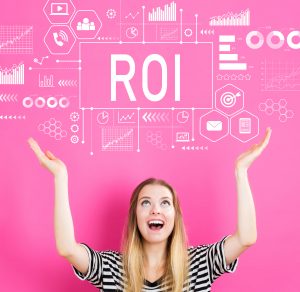“Marketing without data is like driving with your eyes closed.”
– Dan Zarrella
If you want to know how to improve your content marketing strategy, open your eyes and take advantage of the valuable marketing metrics you have at your fingertips. In this article, I will explain why these measures are important, what some of the most valuable metrics are and how you can use these indicators to improve your content marketing campaign and increase your marketing ROI.
Marketing Metrics: Why Are They So Important?
The term “marketing metrics” encompasses any measurable variable that demonstrates the effectiveness of your campaign. But this raw data alone will not tell you much. To get the most out of your marketing metrics, you need to look at the numbers holistically and understand their tangible implications. This will allow you to figure out how you can improve your content marketing strategy and ultimately boost your marketing ROI.
At Three Girls Media, we recommend you review your Google and social media analytics every 4-6 weeks. In addition to analytics tools on each social media platform, there are a variety of social media analytics tools available online.
Top Marketing Metrics
Engagement Metrics
The first category of marketing metrics you should be aware of is engagement. Measures of engagement reveal how users are interacting with your brand across all social media platforms by looking at actions taken on each piece of content you publish. There are multiple engagement metrics worth considering:

- Likes, Comments, Shares and Click-Through Rates: These individual measures of engagement may seem like simple vanity measures, but they can be incredibly useful in determining what kind of content your followers want to see. If certain types of posts consistently perform well, shift your marketing strategy to include more of that content.
- Post Engagement Rate: The total number of engagements on a post divided by the total number of people who saw the post (also known as reach). This marketing metric shows you what percentage of the people who saw the post engaged with it, indicating which types of content may be more effective at boosting engagement.
- Amplification Rate: How many shares your post gets, divided by your total number of followers. Comparing individual shares to total followers will help you know what portion of your followers actively want to associate themselves with your brand. This can help you refine your target audience and the type of content you choose to produce.
- Account Mentions: When a user tags your brand in their own organic content, for example in a post or story. Similarly to amplification rate, account mentions indicate how much of your audience wants to actively engage with your brand.
As you can see, there are many different ways someone can engage with your content. The engagement marketing metrics you choose to analyze will depend on your goals. For example, if your goal is to spark a conversation with your followers, then you may want to measure the replies and comments you receive on a post. On the other hand, if you are hoping to spread a message, you may place more value on shares. Figure out what your goals are and choose which forms of engagement will actually help you measure your success.
Overall, high engagement rates indicate that you have built a loyal following and trust in your brand. If you want to increase engagement with your brand, make sure you are using best practices for each social media platform. Additionally, post content containing a call-to-action to encourage your audience to engage with your posts. If you want more advice for boosting engagement check out this article.
Brand Awareness Metrics
Brand Awareness metrics measure how much attention your brand gets and how familiar your audience is with your brand. There are a two primary marketing metrics that measure brand awareness:

- Impressions: The number of times a piece of content is displayed. An impression is simply how many times your content has been seen by social media users; it does not guarantee any form of engagement. This metric is valuable in assessing how visible your content is to your audience.
- Reach: The number of people who have seen your distributed content. Reach indicates the potential size of your audience for each piece of content you produce, because realistically not every single one of your followers will see your content. Reach is particularly useful in contextualizing engagement metrics. For example, you determine the engagement rate by dividing total engagement by reach to figure out what percent of users who view your post engage with the content. Additionally, this marketing metric can help you see the spread of conversation about your content across social media. There are three types of reach you should measure to give you a holistic assessment of your audience:
- Organic Reach: Users who saw your content on their feed
- Viral Reach: Users who have seen your content because another user shared it
- Paid Reach: Users who saw your content through a promoted social post
Boosting these metrics is valuable because the more aware a potential customer is of your brand, the more likely they will be to purchase from you instead of one of your competitors, resulting in a boost in your marketing ROI. To increase brand awareness, use content marketing best practices and post frequent, quality content on all of your social media platforms. Additionally, sharing content which will build a relationship with your audience is a great way to solidify the impression of your brand in the mind of consumers.
Share of Voice Metrics
Share of voice metrics tell you how well your brand is doing on social media compared to other brands in your field. These marketing metrics specifically look at the visibility of your brand by measuring how frequently your brand is talked about and what kinds of conversations your audience is having about your brand compared to your competitors. There are two share of voice metrics you should know:

- Volume: The number of people talking about your brand on social media. This is a useful marketing metric for understanding how large the conversation around your brand is, and can also aid in determining the size of your highly-engaged audience. Volume is measured through direct mentions (in which users tag your brand) or indirect mentions (in which users may simply mention your brand’s name or one of your products/services).
- Sentiment: The tone of the conversations about your brand. This marketing metric helps you understand how your brand is being perceived by your audience. Are the conversations about your brand revolving around your incredible product or your abysmal customer service? If customer sentiments are not all that positive, it may be time to invest in a few PR strategies.
To increase share of voice metrics, you can use tactics for building your brand through social media marketing. Additionally, increase the volume of your brand by posting content with direct calls to action that encourage your audience to chime in on the conversation. Boosting share of voice marketing metrics is a valuable way to increase your visibility in your professional field, while also ensuring that your brand is viewed in a positive light.
Marketing Cost Metrics & ROI
We have covered the marketing metrics that indicate how your content is preforming on social media and how you can use these metrics to guide future content creation. Now, we move on to the metrics that will help you measure the financial implications of your marketing strategy.

- Return on Marketing Investment (ROMI): Total profit attributed to marketing efforts divided by total marketing investment. ROMI tells you how much money you are making from your marketing strategy in relation to how much you are spending on your marketing efforts. This helps you see if your marketing efforts are actually paying off.
- Customer Acquisition Cost (CAC)/ Cost of Acquisition (COA): The average number of sales and marketing dollars spent to acquire each new customer. This valuable marketing metric tells you how expensive it is to acquire a new customer through your marketing strategy.
- Marketing Originated Customer Percentage: The number of new customers that are a direct result of your marketing compared to total customers. This can help you compare how effective your marketing strategy is at acquiring new customers with how effective your other strategies are at acquiring new customers. You can also look at the number of new customers acquired from different parts of your marketing campaign. For example, you could determine that your Facebook marketing is more effective at acquiring new customers than other social media platforms, in which case you may want to put more of your resources into that platform.
- Referrals: How a user navigates to your website. The referral metric indicates the “source” that a user originated from. For example, if the source is “social” then that person visited your website directly from a social media platform. You can use tracking links or connect your social media accounts and website to analytics programs to see how many people visit your website from each platform. This allows you to determine which content may have prompted a website visit, and consequently which content you may want to produce more of.
- Conversions: When someone completes your desired goal. Typically, a conversion is in response to a call to action such as following a link, purchasing an item, signing up for a newsletter, etc. Conversions stemming from a social media platform are called social conversions.
Understanding these cost and ROI metrics allows you to see the financial results of your marketing efforts, while also continuing to help you refine your campaign. Increasing the previously outlined marketing metrics will likely result in increases in these metrics as well. Boosting any of your cost or ROI metrics will lead to a direct growth in profit for your business. But it is important to remember that you won’t boost your marketing ROI overnight. Running a successful marketing campaign takes time, and you need to learn from your marketing metrics and revise your campaign repeatedly to see significant results.
Need Help Understanding & Improving Your Marketing Metrics?
Do you want more help understanding what your marketing metrics reveal about how you can improve your strategy? Contact us! We’re happy to interpret your metrics, provide direction for your strategy or take care of all of your marketing tactics so you can focus on other areas of your business.
Special Offer:
Sign up for a complimentary consultation during December and receive an Annual Marketing Planning Guide valued at $475! We offer a 30-minute phone consultation with our CEO, and can answer your questions and discuss your specific marketing needs - no strings attached. Call 408-218-2391 or contact us today to arrange your consultation!

